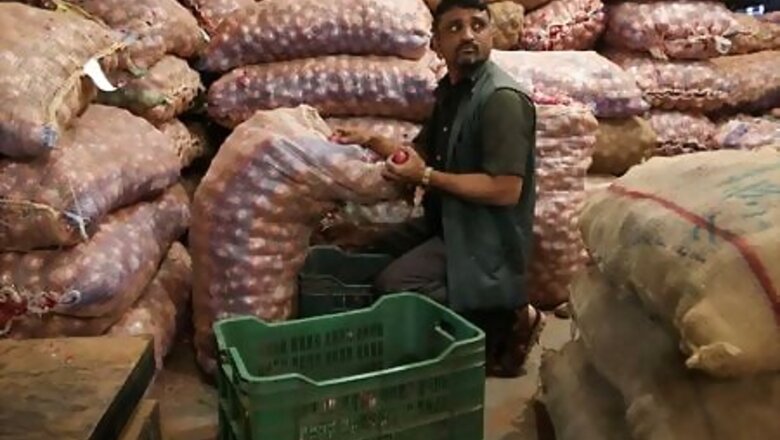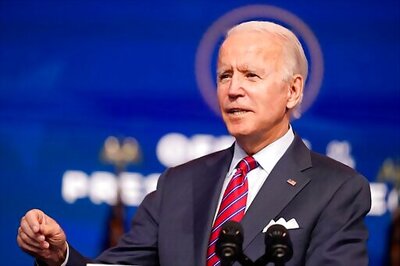
views
India’s retail inflation rose to 6.93% in July on higher food prices, remaining above the RBI’s medium-term target for a 10th straight month, according to government data released on Thursday.
July’s figure was higher than the 6.15% forecast in a Reuters poll of analysts and 6.23% recorded in June.
COMMENTARY
PRITHVIRAJ SRINIVAS, CHIEF ECONOMIST, AXIS CAPITAL, MUMBAI
The inflation uptick is likely to prove temporary since vegetable inflation is in response to supply shortages created by extreme weather, while fuel inflation can be reversed by paring excise from high levels as volumes normalize. Government action is needed to create space for the RBI to ease further.
SIDDHARTHA SANYAL, CHIEF ECONOMIST AND HEAD OF RESEARCH, BANDHAN BANK, KOLKATA
“While the headline print stays higher-than-expected, a significant contribution came in from short-term supply disruptions, especially for primary commodities, and a sharp uptick in prices of precious metals, rather than due to any notable demand overheating.”
“Last week, RBI’s monetary policy committee (MPC) kept the key policy interest rates unchanged, likely taking into account possibility of such elevated headline CPI prints during the coming months.”
“However, one expects retail inflation during H2 FY20-FY21 to likely soften to sub-4% Y/Y. That may open further space for the RBI for further cut in future.”
“We feel that the RBI will remain committed to supporting growth recovery and financial stability over the medium term, despite the upside pressure in CPI prints in the near term.”
SHASHANK MENDIRATTA, ECONOMIST, IBM, NEW DELHI
“The rise in inflation reflects cost-push pressures due to supply issues on account of COVID-19 related disruptions. At the same time, higher taxes on petroleum products have also led to an increase in pump prices. These factors are likely to keep inflation elevated next month as well.”
“The current evolution of inflation reaffirms the RBI’s policy stance of a pause. The central bank is likely to remain vigilant and await a durable reduction in inflation before easing policy rate further.”
KUNAL KUNDU, INDIA ECONOMIST, SOCIETE GENERALE, BENGALURU
“India’s headline CPI printed at 6.9% YOY, driven mainly by food prices which rocketed by 9.6%. Headline CPI remained above the RBI’s upper limit of 6% during seven out of last eight months.”
“Clearly supply disruption continues to play havoc. That said, inching up core inflation is a concern. However, we think the high reading will merely push back the timeline for further rate-cuts, though rate-cuts are expected to take place by 4Q20 or 1Q21.”
SAKSHI GUPTA, SENIOR ECONOMIST, HDFC BANK, GURUGRAM
“The inflation print has surprised on the upside in July. While the pickup in vegetable inflation was factored in, the broad-based increase in other categories such as proteins items was unexpected and drove the overall food basket higher in July.”
“Bottomline is we could be looking at higher inflation prints for the next few months due to supply side disruptions playing havoc for food prices, while core inflation continues to remain sticky despite weak demand.”
“We think that the policy space in terms of further rate cuts is becoming increasingly limited and the chances of the RBI staying pat even in October has risen. Depending on the inflation trajectory towards the end of the year there could be space for a further cut of 25-50bps. We expect inflation to now touch close to 5% average for the fiscal year.”
ADITI NAYAR, PRINCIPAL ECONOMIST, ICRA, GURUGRAM
“The CPI inflation hardened to a sharper-than-anticipated 6.9% in July 2020, led by core items that are still adjusting to the new demand-supply dynamics, even as the increase in food inflation was along expected lines.”
“The evolving trends for the ongoing month suggest that the CPI inflation may remain appreciably above 6% in August, which would be the last inflation print available before the next scheduled MPC review.
“Accordingly, the likelihood that the MPC would persist with a pause in its October meeting has climbed sharply, with a final rate cut likely to be deferred to the December 2020 or February 2021 meeting.”
ANAGHA DEODHAR, ECONOMIST, ICICI SECURITIES, MUMBAI
“Headline inflation for July is above my expectations. I was expecting a print of 6.4%-6.5%. Rising food prices drove the inflation up for yet another month.”
“Five food categories accounting for 18% of CPI basket recorded double-digit inflation which is worrying. Given the sequential momentum in food prices and low base, we expect food prices to remain high in August as well.”
“More worryingly, core inflation for the month is at 5.9% indicating supply disruptions are affecting services inflation as well. Given this number and expected trajectory of inflation, we believe the window for next rate cut will not open before December 2020.”
RAHUL GUPTA, HEAD OF RESEARCH- CURRENCY, EMKAY GLOBAL FINANCIAL SERVICES, MUMBAI
“CPI has come much higher than market expectations. The CPI remains above RBI’s target range mainly due to an uptick in food inflation.”
“Despite the nationwide lockdown easing, food inflation still remains a concern as regional lockdown still persists.”
“Eventually, with better monsoon and further easing of the lockdown, we can expect inflation to come under RBI’s target range. But as long as CPI hovers above 6%, RBI will remain hesitant on cutting repo rate.”
SUJAN HAJRA, CHIEF ECONOMIST, ANAND RATHI SECURITIES, MUMBAI
“The inflation number was much higher-than-expected. This is mostly due to higher food prices. As restrictions further ease, this too will pass. The RBI in its August policy said it expected inflation to remain high in the quarter ending September. So, this doesn’t change much as growth remains the main priority. But this makes rate-cut in the October policy meeting slightly uncertain. But by December, I expect the RBI to come to rate-cutting mode.”
RUPA REGE NITSURE, GROUP CHIEF ECONOMIST, L&T FINANCIAL HOLDINGS, MUMBAI
“The CPI print is along expected lines and justifies in retrospect the RBI’s decision to take a pause in the rate reduction cycle.”
“RBI has been supporting the system by using appropriate tools like liquidity and restructuring facility. Given the distortions in supply chains and transportation, I don’t expect a rate cut in the remaining part of 2020.”
“Liquidity support will, however continue and prevent a sharp reversal of benign interest rates.”
SUVODEEP RAKSHIT, SENIOR ECONOMIST, KOTAK INSTITUTIONAL EQUITIES, MUMBAI
“CPI inflation at 6.93% was much higher than consensus estimates, led by higher food inflation. Clearly, supply chain issues have been feeding through the food prices, especially vegetables and partly from higher fuel prices.”
“The magnitude was a surprise though the direction was broadly expected. However, over the next few months, food prices should normalise though seasonally food prices do see some uptick in the June-September period.”
“In terms of the monetary policy, the RBI MPC is likely to remain on pause in the October policy meeting and will reconsider once inflation moves firmly below the 6%-mark and steadily declines towards 4%.”
Disclaimer: This post has been auto-published from an agency feed without any modifications to the text and has not been reviewed by an editor



















Comments
0 comment